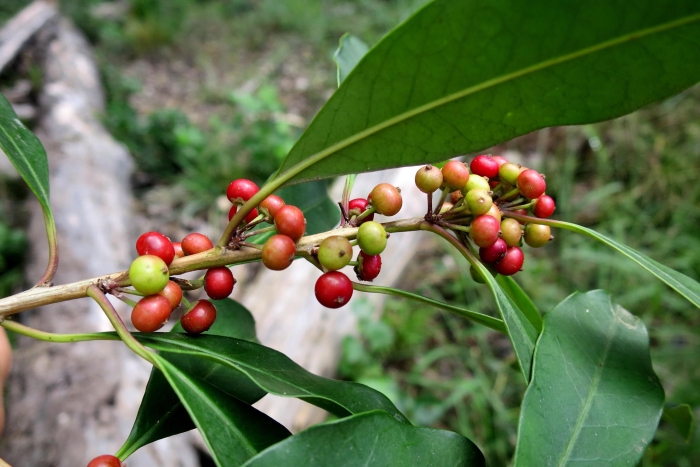Cape Holly
(Ilex mitis)
Cape Holly (Ilex mitis)
/
/

Di Turner
Public Domain
Image By:
Di Turner
Recorded By:
Copyright:
Public Domain
Copyright Notice:
Photo by: Di Turner | License Type: Public Domain | License URL: http://creativecommons.org/publicdomain/zero/1.0/ | Rights Holder: Di Turner | Publisher: iNaturalist | Date Created: 42450 |
























































Estimated Native Range
Summary
Ilex mitis, commonly known as Cape Holly, is an evergreen tree native to Afromontane forests, coastal forests, and riverine woodlands in Eastern and Southern Africa, as well as Madagascar. It typically grows to a height of 18-36 feet (5.5-11 meters) and a width of 6-15 feet (1.8-4.5 meters). The tree has a straight trunk with a dense canopy, and its glossy, dark green leaves resemble those of the European holly. Cape Holly produces small, white, fragrant flowers in the spring and summer, which are followed by red to purple berries that attract birds and other wildlife.
Cape Holly is valued for its ornamental appearance, fast growth, and ability to form a tall, dense hedge, making it an excellent choice for privacy screens and windbreaks in gardens. It is also suitable for urban planting due to its tolerance of air pollution. This species thrives in full sun to part shade and prefers moist, well-drained soils, although it can tolerate a range of soil types. It is frost-tolerant, which allows it to be used in colder climates. Fresh seeds of Ilex mitis have a good germination rate after being slightly dried. Young plants should be kept moist and protected from direct sunlight until established. While it is generally disease-free, occasional issues with scale insects or leaf miners may occur. It is not known to have aggressive roots or to be invasive when grown outside its native range.CC BY-SA 4.0
Cape Holly is valued for its ornamental appearance, fast growth, and ability to form a tall, dense hedge, making it an excellent choice for privacy screens and windbreaks in gardens. It is also suitable for urban planting due to its tolerance of air pollution. This species thrives in full sun to part shade and prefers moist, well-drained soils, although it can tolerate a range of soil types. It is frost-tolerant, which allows it to be used in colder climates. Fresh seeds of Ilex mitis have a good germination rate after being slightly dried. Young plants should be kept moist and protected from direct sunlight until established. While it is generally disease-free, occasional issues with scale insects or leaf miners may occur. It is not known to have aggressive roots or to be invasive when grown outside its native range.CC BY-SA 4.0
Plant Description
- Plant Type: Tree
- Height: 18-36 feet
- Width: 6-15 feet
- Growth Rate: Moderate
- Flower Color: White
- Flowering Season: Spring, Summer
- Leaf Retention: Evergreen
Growth Requirements
- Sun: Full Sun, Part Shade
- Water: Medium, High
- Drainage: Medium
Common Uses
Bee Garden, Bird Garden, Butterfly Garden, Deer Resistant, Hedges, Low Maintenance, Rabbit Resistant
Natural Habitat
Afromontane forests, coastal forests, and riverine woodlands
Other Names
Common Names: African Holly, Waterboom, Umduma, Water-Tree, Wild Holly, Busofu, Kaneke, Kanyamushanga, Keyanike, Mueshe
Scientific Names: , Ilex mitis, Ilex monticola, Ilex mitis var. mitis, Ilex capensis, Myrsine mitis, Sideroxylon mite, Sideroxylon nigricans, Celastrus sieberi, Manglilla milleriana
GBIF Accepted Name: Ilex mitis (L.) Radlk.